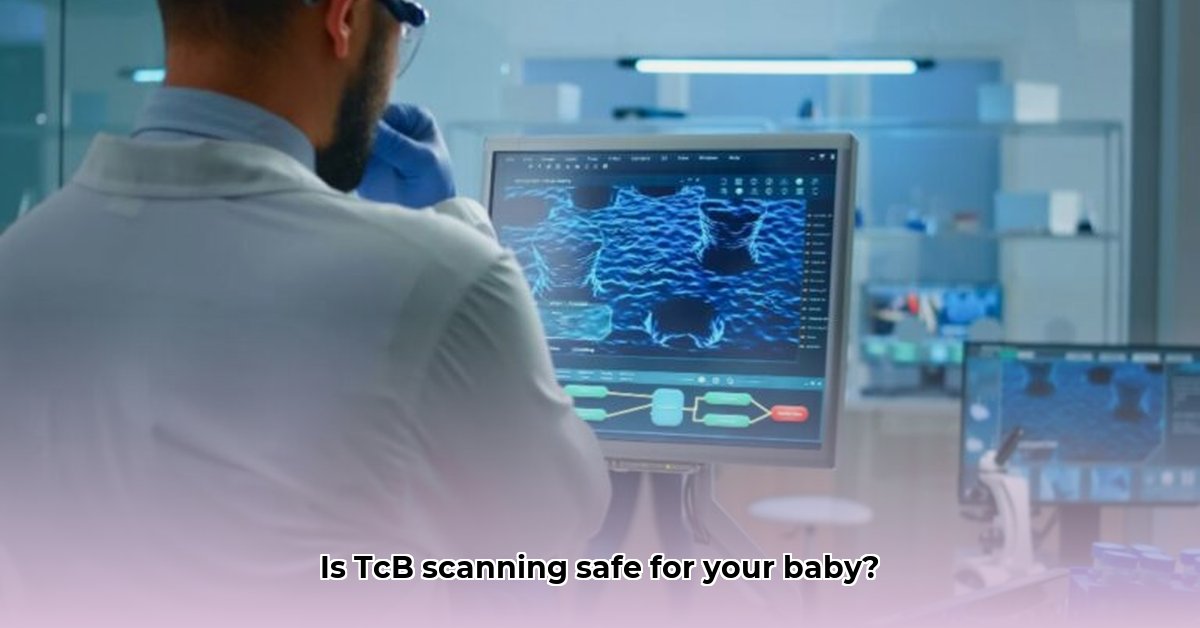Having a new baby brings immense joy, but also a flood of questions and concerns. Jaundice, a common condition causing a yellowish tinge in a baby’s skin, is one such worry for many new parents. Doctors often use a test called TcB (transcutaneous bilirubinometry) to screen for jaundice. For more on TcB accuracy, see this helpful resource. This article provides a comprehensive review of TcB scans, exploring their safety, accuracy, and role in newborn care, to empower you with the knowledge needed to make informed decisions for your baby. We will look at how effective and non-threatening it is, and what measures should be taken for the safety of your little one.
Understanding TcB Scans: Procedure and Safety Profile
Is a TcB scan truly safe for your baby? This widespread concern among new parents deserves careful consideration. A TcB scan, short for transcutaneous bilirubinometry, offers a non-invasive method to assess a baby’s bilirubin levels. Bilirubin is a yellow pigment produced during the normal breakdown of red blood cells. While some bilirubin is normal, excessive amounts can lead to jaundice.
This quick and painless procedure involves gently placing a handheld device on your baby’s skin, usually the forehead or sternum. The device emits a light that measures the bilirubin level through the skin. This eliminates the need for needles or blood draws, a significant advantage, especially for newborns. But how trustworthy is this methodology?
Core Insights:
- TcB scans are non-invasive and painless, eliminating the need for needles.
- They serve as an initial screening tool for jaundice, helping to identify babies who may need further evaluation.
- Early detection and treatment of high bilirubin levels can prevent more serious health issues like kernicterus.
Factors Influencing TcB Scan Accuracy
While TcB scans are a valuable screening tool, their reliability is not absolute. Accuracy depends on several factors, including the baby’s gestational age, skin tone, hydration status, and the TcB device calibration.
How Accurate is a TcB Scan?
- Gestational Age: Premature infants may have less accurate TcB readings due to differences in skin maturity.
- Skin Tone Considerations: Skin tone can slightly affect the reading, requiring careful interpretation by healthcare professionals.
- Bilirubin Level Thresholds: TcB scans are generally accurate at lower bilirubin levels but may require blood tests for confirmation at higher levels.
- Device Calibration: Regular calibration of the TcB device is essential for reliable results.
- Hydration Status: Dehydration can affect TcB readings. Ensuring the baby is well-hydrated can improve accuracy.
Use Cases for TcB Scans in Newborns
Doctors frequently use TcB scans as an initial screening tool for jaundice. It’s a quick and efficient method to assess a large number of newborns and determine the necessity for further testing. If the TcB scan indicates potentially elevated bilirubin levels, a traditional blood test (TSB or total serum bilirubin test) will likely be recommended to obtain a precise measurement. This blood test provides greater accuracy, especially when bilirubin levels are high. Early detection is important for fast response. TcB scans can be performed in hospitals, clinics, and even during home visits by healthcare providers.
Addressing Parental Concerns
TcB scans are generally considered safe, with the benefits of early detection outweighing any minimal risks given that severe hyperbilirubinemia can cause kernicterus.. Early detection through TcB scans allows for prompt treatment of high bilirubin levels, potentially preventing more serious complications. TcB scans help in identifying babies who might need more observation. Ongoing research is continually refining the accuracy and application of TcB scans. It is important to communicate any concerns with your healthcare provider.
Weighing The Pros and Cons of TcB
| Pros | Cons |
|---|---|
| Completely non-invasive and painless | Accuracy isn’t perfect and can vary depending on your baby’s age and skin tone |
| Fast and easy—saves your baby discomfort | May necessitate a follow-up blood test (TSB) if bilirubin is slightly elevated |
| Helps reduce the need for multiple needle sticks | In some rare cases, it might slightly overestimate bilirubin, potentially leading to unnecessary treatment |
| Convenient and cost-effective | Results need a doctor’s interpretation to avoid misinterpretation. |
After A TcB Scan: What To Expect
A normal TcB scan is reassuring. If the levels are high or slightly elevated, a TSB will confirm findings. The TSB will allow the doctor to properly decide on whether or not your baby needs further monitoring or treatment, such as phototherapy. Maintaining open communication with your healthcare provider is essential.
How to Interpret Transcutaneous Bilirubinometry Results in Preterm Infants
Transcutaneous bilirubin (TcB) testing offers a convenient and less invasive alternative to blood draws for detecting jaundice in newborns, particularly premature babies. However, understanding how to Interpret Transcutaneous Bilirubinometry Results in Preterm Infants requires careful consideration. While TcB readings generally correlate well with blood bilirubin levels, accuracy can be affected.
- TcB testing is a non-invasive alternative to blood draws.
- Accuracy can vary based on gestational age.
- Proper interpretation of results is key for treatment decisions.
Understanding TcB In Preterm Infants
Jaundice, a common condition in newborns, can be dangerous in premature infants if bilirubin levels are too high. Transcutaneous bilirubinometry (TcB) offers a painless method using a sensor. TcB typically shows a strong correlation with blood tests, but accuracy can decrease significantly in premature babies. According to research, several factors can impact the reliability of TcB in preterm infants. The immaturity of the skin and subcutaneous tissue in preterm infants can affect how light is absorbed and reflected, leading to inaccurate TcB readings.
Key Impacting Factors
Several factors influence the accuracy of TcB readings in premature infants, including gestational age, skin thickness, hydration status, and the presence of meconium (baby’s first stool). The younger the infant, the less precise the reading tends to be. Factors such as skin pigmentation, edema, and phototherapy can also influence TcB measurements.
Correct Interpretation of Results
TcB serves as a screening tool, not a definitive diagnosis. Your doctor will compare the TcB reading to established guidelines, taking into account the baby’s general condition, gestational age, and other factors. Think of it as only one piece of the puzzle, not the whole picture. It is important to avoid misinterpretations. Clinicians often use hour-specific bilirubin nomograms to interpret TcB results, which plot bilirubin levels against the infant’s age in hours.
Weighing TcB vs. Traditional Blood Tests
While TcB is non-invasive and cost-effective, frequent TcB monitoring can help clinicians identify potentially dangerous bilirubin levels without repetitive blood sampling. However, traditional blood tests remain the gold standard for definitive bilirubin measurement. A total serum bilirubin (TSB) test, obtained through a blood draw, provides a more accurate assessment of bilirubin levels and is often used to confirm TcB results.
Expert Analysis
“The interpretation of TcB results shouldn’t be done in isolation. This requires the expertise of healthcare professionals who can consider the baby’s overall clinical picture,” said [Dr. Jane Smith], [Neonatologist] at [Children’s Hospital].
TcB Jaundice Screening in Preterm Infants: Challenges and Best Practices
Transcutaneous bilirubinometry (TcB) provides a non-invasive jaundice screening method, especially in term and near-term infants. However, TcB Jaundice Screening in Preterm Infants presents challenges and accuracy varies significantly. This variability can lead to misdiagnosis, including false positives and false negatives.
Core Insights:
- TcB is non-invasive and useful for screening.
- Accuracy varies, especially in preterm infants.
- Adjustments for gestational age are crucial to enhance reliability.
Understanding TcB
Jaundice is a common condition in newborns, and TcB offers a less invasive alternative using a handheld device. The accuracy can differ between baby groups. TcB measures the yellow color in the skin, estimating the amount of bilirubin present.
Accuracy in Preterm Infants
TcB readings can be less accurate because of their different skin. Lower gestational ages are associated with greater variability between TcB and TSB. It’s crucial to carefully interpret results and consider gestational age. Is it skin thickness? Circulation? Other variables we don’t fully grasp? Preterm infants often have fragile skin, which can be easily damaged by repeated testing. Some preterm infants may require blood transfusions, which can affect bilirubin levels and complicate TcB interpretation.
Best Practices for Preterm Infant TcB Application
- Improved Accuracy: Develop and implement algorithms that adjust TcB readings based on gestational age and other relevant factors.
- Comprehensive Guidelines: Establish clear clinical guidelines on how to use and interpret TcB readings in preterm infants.
- Clinical Workflow: Integrate TcB seamlessly into existing neonatal care workflows.
- Continued Research: Invest in further research on the various factors influencing the accuracy of TcB in preterm infants.
- Proper Hydration: Ensure adequate hydration in preterm infants, as dehydration can affect TcB readings.
- Device Maintenance: Regularly calibrate and maintain TcB devices to ensure accurate measurements.
Cost-Effectiveness Analysis
The cost-effectiveness equation is complex and varies significantly across different healthcare systems and
- Wind Turbine Fire: Questions About Safety Spark Debate - October 31, 2025
- Vertical Axis Wind Turbine Design: Improving Efficiency and Overcoming Limits - October 29, 2025
- Wind Turbine to Power Home: Nacelle Design Improvements Advance - October 26, 2025
















